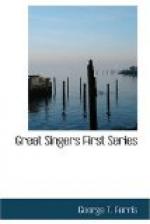* Addison gives some
such description of the French opera in
No. 29 of the “Spectator.”
Having told you what others say of this brilliant spectacle, I will now tell you what I have seen myself. Imagine an inclosure fifteen feet broad and long in proportion; this inclosure is the theatre. On its two sides are placed at intervals screens, on which are grossly painted the objects which the scene is about to represent. At the back of the inclosure hangs a great curtain painted in like manner, and nearly always pierced and torn, that it may represent at a little distance gulfs on the earth or holes in the sky. Every one who passes behind this stage or touches the curtain produces a sort of earthquake, which has a double effect. The sky is made from certain bluish rags suspended from poles or from cords, as linen may be seen hung out to dry in any washerwoman’s yard. The sun (for it is seen here sometimes) is a lighted torch in a lantern. The cars of the gods and goddesses are composed of four rafters, squared and hung on a thick rope in the form of a swing or seesaw; between the rafters is a cross-plank on which the god sits down, and in front hangs a piece of coarse cloth well dirtied, which acts the part of clouds for the magnificent car. One may see toward the bottom of the machine two or three stinking candles, badly snuffed, which, while the great personage dementedly presents himself, swinging in his seesaw, fumigate him with an incense worthy of his dignity. The agitated sea is composed of long lanterns of cloth and blue pasteboard, strung on parallel spits which are turned by little blackguard boys. The thunder is a heavy cart, rolled over an arch, and is not the least agreeable instrument one hears. The flashes of lightning are made of pinches of rosin thrown on a flame, and the thunder is a cracker at the end of a fusee. The theatre is furnished, moreover, with little square trap-doors, through which the demons issue from their cave. When they have to rise into the air, little devils of stuffed brown cloth are substituted, or perhaps live chimney-sweeps, who swing suspended and smothered in rags. The accidents which happen are sometimes tragical, sometimes farcical. When the ropes break, then infernal spirits and immortal deities fall together, laming and sometimes killing each other. Add to all this the monsters which render some scenes very pathetic, such as dragons, lizards, tortoises, and large toads, which promenade the theatre with a menacing air, and display at the opera all the temptations of St. Anthony. Each of these figures is animated by a lout of a Savoyard, who has not even intelligence enough to play the beast.” Saint Preux is also made to say of the singers: “One sees actresses nearly in convulsions, tearing yelps and howls violently out of their lungs, closed hands pressed on their breasts, heads thrown back, faces inflamed, veins swollen, and stomach panting. I know not which of the two, eye or ear, is more agreeably




